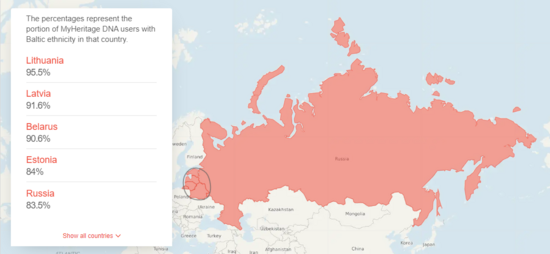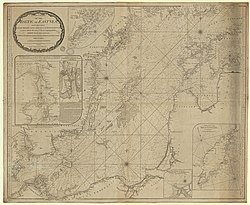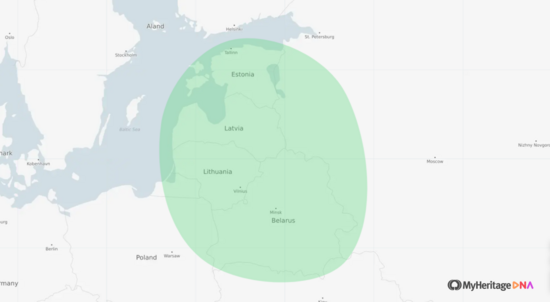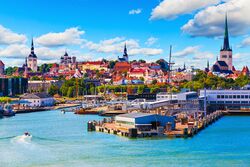
Baltic ethnicity indicates genetic origins in Estonia, Latvia, and Lithuania, which are the three countries that make up the Baltic states: a geographic rather than ethno-cultural term. While the majority of Latvians and Lithuanians are of Baltic origin (commonly known as Balts), the majority of Estonians have Finnic origins. The Baltic states, located on the eastern shore of the Baltic Sea, derive their name from the body of water, rather than vice versa. While most Balts live within the borders of their ethnic homeland, economic factors have prompted Latvians and Lithuanians to emigrate to other regions during the nineteenth, twentieth, and twenty-first centuries — including neighboring Baltic states, Europe, the Americas, and Australia. Prior to World War II, Lithuania housed a substantial Jewish community (Vilnius, nicknamed “Northern Jerusalem,” was 30% Jewish), most of which was annihilated during the Holocaust. Many of the survivors later immigrated to the U.S., South Africa, and Israel.
Baltic history

The predecessors of the modern Balts inhabited an area stretching from what is now central Russia to the mouth of the Vistula River in Poland, including large parts of present-day Russia, Belarus, Latvia, Lithuania, and northern Poland. The southward expansion of Germanic tribes from Scandinavia in the eighth century and the westward expansion of Slavic tribes in the tenth century put the Balts under pressure, compressing their habitat to its modern size. The Scandinavian and East Slav incursions were accompanied by efforts to introduce Christianity among the Balts. Prior to Christianity, Balts worshiped the forces of nature, personified as divinities, in sacred oak groves. Their ancient religious and cultural life is primarily known from the large body of folk songs, dainos, many of which have survived and are today central to their heritage. By the end of the thirteenth century, Germanic forces had successfully subdued the Balts of Latvia, while Lithuanians — residing in less accessible dense forests and swamplands — withstood foreign incursions. In the fourteenth century, the Lithuanian Gediminas dynasty established an entity encompassing the lands of modern-day Lithuania, Belarus, and northwestern Ukraine, reaching as far east as Moscow. Lithuanian princes frequently intermarried with local ruling families; the marriage of one Lithuanian prince with a Polish queen led Lithuania to become part of the Roman Catholic world. In the sixteenth century, Russian Tsar Ivan IV, more commonly known as Ivan the Terrible, overran the Lithuanian-Polish union and broke the region up into three duchies — Couland, Livonia, and Estland — an administrative division that persisted until 1917. Sweden ruled the northern reaches of the Baltic region for a short but prosperous period. Starting from the second half of the seventeenth century, the Russians placed increasing pressure on the Baltic region, which by the end of the eighteenth century was fully incorporated into the Russian Empire. The nineteenth century saw a policy of Russianization in the Baltics, which replaced the prevalent German cultural influence in the region. The use of the Russian language became mandatory in all areas of public life, including education. However, in the late nineteenth century, nationalist sentiment grew in Estonia and Latvia and gained traction following the 1905 Russian Revolution. After World War I, Lithuania, Latvia, and Estonia gained their independence.

In 1940, the Soviet Union occupied the Baltic states, and a rapid process of Sovietization followed. A turbulent period of Soviet control, which saw the displacement and deportation of tens of thousands of people, was interrupted by the Nazi occupation. From 1944–1945, the Baltics were re-occupied by the Red Army and Soviet rule was re-established. In late 1980s a massive campaign of civil resistance against Soviet rule began, including the Baltic Way — a human chain comprising 2 million people — which stretched for 600 kilometers from Tallinn to Vilnius. The event contributed to the dissolution of the Soviet Union and the subsequent reassertion of Baltic independence in 1991. Today, all three Baltic states are parliamentary democracies and members of the European Union and NATO.
Baltic culture
The Baltic states share deep historic ties, including German, Swedish, and Russian cultural influences. Baltic cuisine features produce typical to the cold Baltic climate, such as barley, potatoes, beets, berries, and mushrooms. Evidence of Slavic influence — first of Tsarist Russia and later the Soviet Union — can be felt in some of the region’s most common dishes, including dumplings (koldūnai in Lithuania, pelmeni in Latvia) and beet soup (šaltibarščiai in Lithuania, aukstā zupa in Latvia), while the prominence of pickled herring in Baltic cuisine is testimony to Nordic influence.
Lithuanians share a strong sense of national cohesion, manifested in traditional folk music and national holidays. The country’s rich cultural heritage is reflected in the recognition of eleven sites as UNESCO World Heritage Sites, including the historic center of Vilnius, the Curonian Sit, and the Kernavė archeological site. UNESCO’s Intangible Cultural Heritage List also includes Lithuania’s song and dance festival tradition, its iron cross-crafting and the symbolism of this artistic form, and sutartinės: traditional Lithuanian polyphonic songs.

Latvian culture is deeply embedded in traditional folklore, including the Summer Solstice or “Jāņi” holiday, celebrated by making garlands of oak leaves or wildflowers, going to the sauna, drinking beer, and the consumption of caraway cheese. Latvian folklore still resonates through traditional crafts and handiwork: National costumes reflect the social and marital status, age, and wealth of the individual wearer, and are still worn today during national holidays. The rich heritage of Latvian national costumes — a matter of national pride — can be appreciated at “Senā Klēts” (“old granary”), the National Costumes Center, a research institution and the largest collection of original and restored Latvian costumes.
Baltic languages
Latvian and Lithuanian peoples speak Baltic languages, a branch of the Indo-European language family. Originally spoken by tribes of central Eastern Europe in the west to the Moscow, Oka, and Volga river basins in the east, the Baltic languages form a part of the wider group of Balto-Slavic languages.
Explore more about ethnicity estimates
- MyHeritage DNA
- Ethnicities around the world at MyHeritage
- What Is My Ethnicity? How MyHeritage Estimates Ethnicities at MyHeritage Knowledge Base
- Where's My Ethnicity?!: Why An Ethnicity Might Not Show Up In Your DNA (and How To Find Evidence Of It Anyway) at MyHeritage Knowledge Base